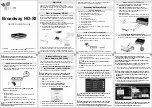
– –
– –
18
19
Addressing Modes
The module has very flexible addressing methods selected with the
register. It can be changed during operation. The transmitting
module addresses packets according to the addressing mode
configuration. The receiving module processes all addressing types
regardless of the
configuration. If the received message
matches the addressing criteria, it is output on the UART. Otherwise it is
discarded. The
configuration also enables assured delivery.
There are three addressing modes: DSN, User and Extended User. Each
mode offers different communications methods, but all use source and
destination addressing. The source address is for the transmitting unit,
the destination address is the intended receiver. Each mode uses different
registers for the source and destination addresses.
All three addressing modes can be configured to be compatible with the
older 250 Series modules. The default operation has an additional level
of masking on the receiving module that helps prevent interference from
adjacent networks.
The following sections give brief descriptions of the three modes, but a
detailed explanation and examples are given in RG-00105, the HumPRO
TM
Addressing Mode Reference Guide.
DSN Addressing Mode
Device Serial Number Addressing mode is the simplest mode and
supports point-to-point communications. Each module is programmed at
the factory with a unique 4-byte serial number that cannot be changed.
These bytes are found in the non-volatile read-only
registers
(
[3-0]). DSN Addressing mode uses this serial number as an
address. The transmitting unit’s DSN is used as the source address and
the intended receiver’s DSN is written into the destination address registers
(
[3-0]). All modules within range hear the transmission, but only
the module with the serial number that matches the destination address
outputs the data on its UART. All others ignore the transmission.
User Addressing Mode
User Addressing Mode is a more flexible method than DSN Addressing
Mode. It uses the customer ID bytes (
[1-0]) for unencrypted
messages and two of the user destination bytes (
destination address. The customer ID bytes are programmed at the factory
and cannot be changed. These are determined by the factory for specific
customers to prevent their systems from operating with any other systems.
Contact Linx for more details.
The module’s local address is contained in two of the user source ID
registers (
[1-0]). In this mode, USRCID [1-0] contain the node
address and
[3-2] must be 0 in the receiver.
In normal operation each module has a user ID mask (
splits the 32 address bits into up to three fields to provide a network
address and address fields for sub-networks, supporting both individual
addressing and broadcast addressing within the user’s network. A detailed
explanation and examples are given in Reference Guide RG-00105. The
16 bits in the
[1-0] registers are transmitted. The upper 16 bits of
[3-2] in the receiver must be 0.
If acknowledgements are enabled, only the module with a user source ID
that exactly matches the transmitted user destination ID responds. The
mask is not used for this determination.
Extended User Addressing Mode
Extended User Addressing mode is the same as User Addressing mode
but uses 32-bit addresses. The two customer ID bytes are still used
(
[1-0]) for unencrypted messages but four bytes are used for the
user destination address (
[3-0]) and
user ID mask (
[3-0]). This provides more addressing capabilities at
the expense of more overhead in the packet.
Network Addressing
Network Addressing is selected by setting
to 0x03. It allows
the receiver to receive all messages sent in User Address or Extended
User Address mode with a destination address matching the
group 1 bits (continuous high-order zero bits in
with
= 0x12345678 and
= 0x000FFFFF, messages with
destination address 0x123zzzzz, where z is any value, is received.
Содержание EVM-900-PRO
Страница 1: ...HumPRO ATM Series 900MHz RF Transceiver Module Data Guide...
Страница 60: ...114 115 Notes...













































